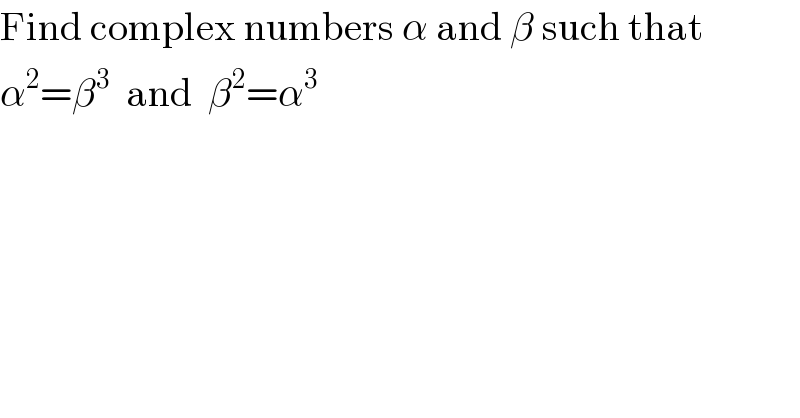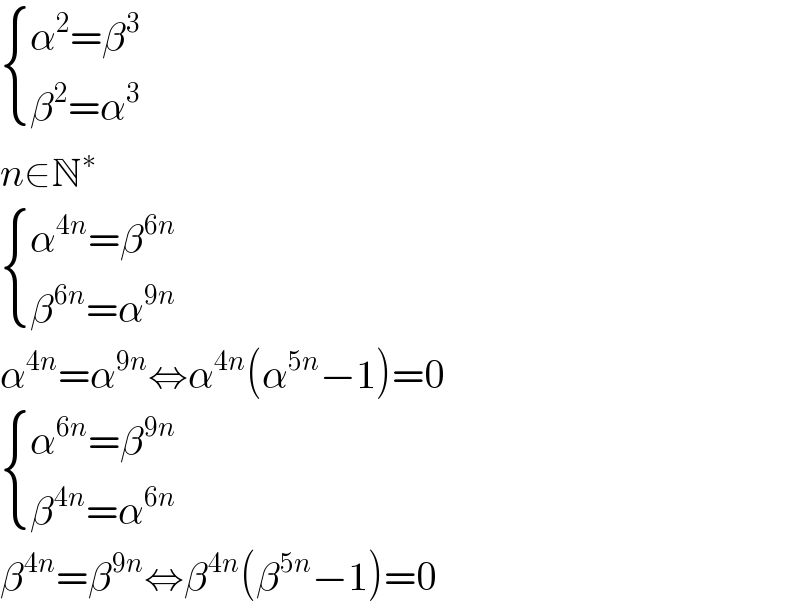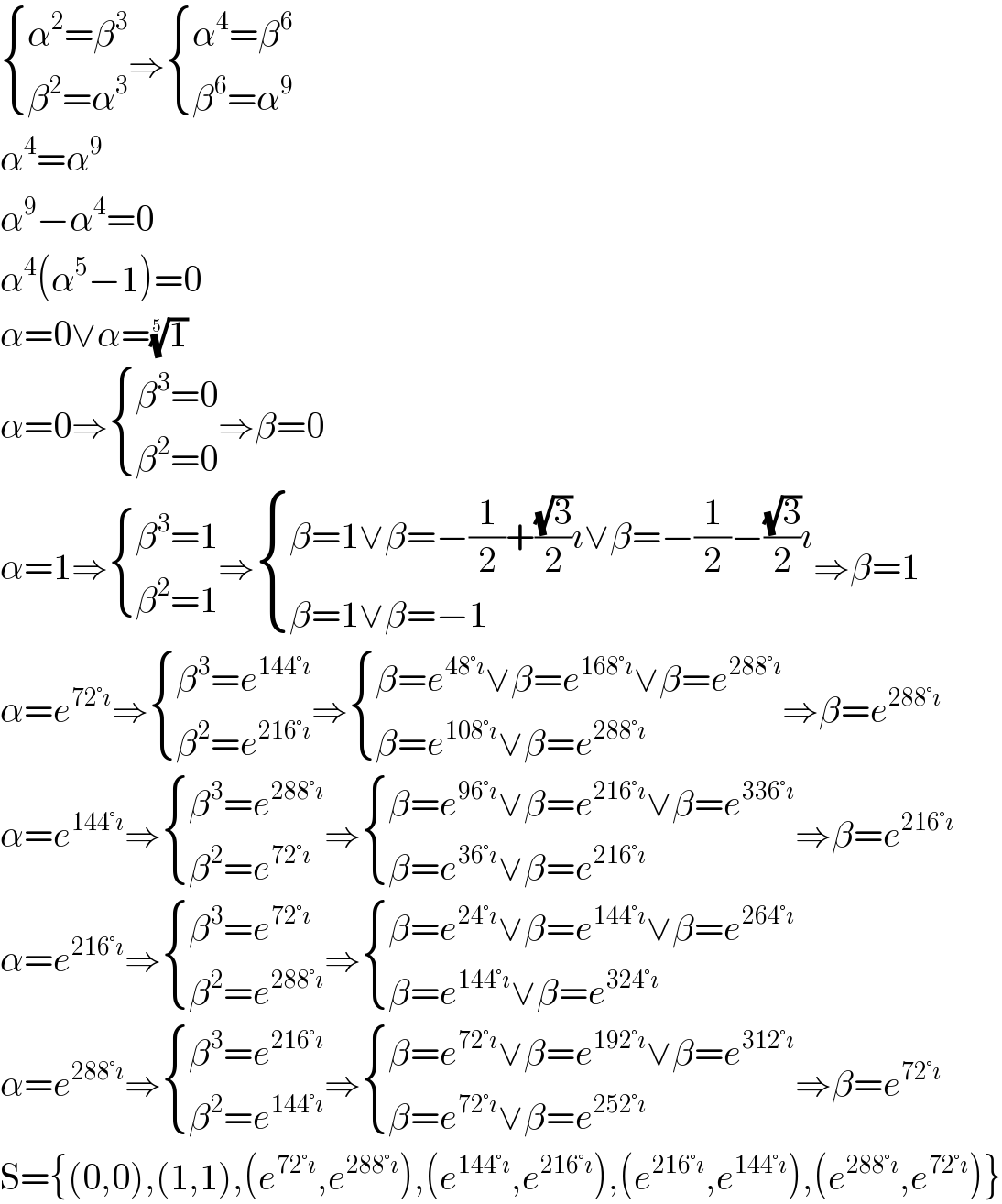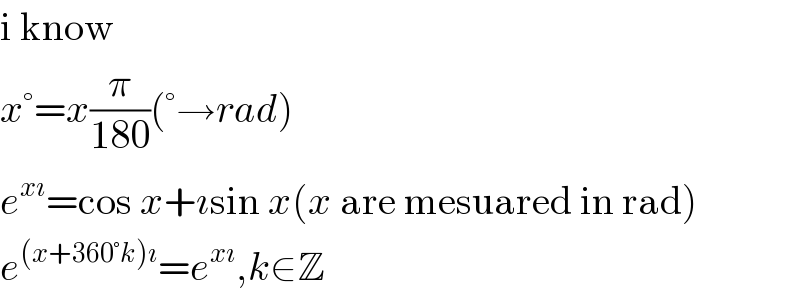
Question Number 1497 by Rasheed Soomro last updated on 14/Aug/15

$$\mathrm{Find}\:\mathrm{complex}\:\mathrm{numbers}\:\alpha\:\mathrm{and}\:\beta\:\mathrm{such}\:\mathrm{that} \\ $$$$\alpha^{\mathrm{2}} =\beta^{\mathrm{3}} \:\:\mathrm{and}\:\:\beta^{\mathrm{2}} =\alpha^{\mathrm{3}} \\ $$
Commented by 123456 last updated on 14/Aug/15

$$\left(\alpha,\beta\right)=\left(\mathrm{0},\mathrm{0}\right)\:\mathrm{is}\:\mathrm{ome}\:\mathrm{of}\:\mathrm{these}\:\mathrm{pairs} \\ $$
Commented by Rasheed Ahmad last updated on 14/Aug/15

$$\left(\mathrm{1},\mathrm{1}\right)\:{is}\:{an}\:{other}\:{pair}. \\ $$
Commented by 123456 last updated on 15/Aug/15

$$\begin{cases}{\alpha^{\mathrm{2}} =\beta^{\mathrm{3}} }\\{\beta^{\mathrm{2}} =\alpha^{\mathrm{3}} }\end{cases} \\ $$$${n}\in\mathbb{N}^{\ast} \\ $$$$\begin{cases}{\alpha^{\mathrm{4}{n}} =\beta^{\mathrm{6}{n}} }\\{\beta^{\mathrm{6}{n}} =\alpha^{\mathrm{9}{n}} }\end{cases} \\ $$$$\alpha^{\mathrm{4}{n}} =\alpha^{\mathrm{9}{n}} \Leftrightarrow\alpha^{\mathrm{4}{n}} \left(\alpha^{\mathrm{5}{n}} −\mathrm{1}\right)=\mathrm{0} \\ $$$$\begin{cases}{\alpha^{\mathrm{6}{n}} =\beta^{\mathrm{9}{n}} }\\{\beta^{\mathrm{4}{n}} =\alpha^{\mathrm{6}{n}} }\end{cases} \\ $$$$\beta^{\mathrm{4}{n}} =\beta^{\mathrm{9}{n}} \Leftrightarrow\beta^{\mathrm{4}{n}} \left(\beta^{\mathrm{5}{n}} −\mathrm{1}\right)=\mathrm{0} \\ $$
Commented by Rasheed Soomro last updated on 16/Aug/15
![α^2 =β^3 (α^2 )^2 =(β^( 3) )^2 α^4 =(β^( 2) )^3 α^4 =(α^3 )^3 [substituting β^( 2) =α^3 ] α^4 =α^9 Assuming α≠0,dividing by α^4 α^5 =1⇒α=^5 (√1) Similarily , β^( 5) =1⇒β=^5 (√1) ∴ α and β both are 5th roots of unity. We know that nth root of unity=(cos((2π)/n)+ı sin((2π)/n) )^k , k=0,1,2,...(n−1) 5th root of unity=(cos((2π)/5)+ı sin((2π)/5) )^k , k=0,1,2,...4 Let cos((2π)/5)+ı sin((2π)/5) =ω 5th root of unity=1,ω,ω^2 ,ω^3 ,ω^4 (in order) Square of ∽ =1,ω^2 ,ω^4 ,ω,ω^3 (in order) Cube of ∽ =1,w^3 ,ω,ω^4 ,ω^2 (in order) (𝛚^k_1 )^2 = (𝛚^k_2 )^3 k_1 , k_2 = 0,1,2,3,4 𝛚^(2k_1 (mod 5)) =𝛚^(3k_2 (mod 5)) For 2k_1 (mod 5)=3k_2 (mod 5) : (α,β)=(ω^k_1 , ω^k_2 )=(ω^k_2 , ω^k_1 ) (α,β)={(1,1),(ω,ω^4 ),(ω^4 ,ω),(ω^2 ,ω^3 ),(ω^3 ,ω^2 )}](Q1517.png)
$$\alpha^{\mathrm{2}} =\beta^{\mathrm{3}} \\ $$$$\left(\alpha^{\mathrm{2}} \right)^{\mathrm{2}} =\left(\beta^{\:\mathrm{3}} \right)^{\mathrm{2}} \\ $$$$\alpha^{\mathrm{4}} =\left(\beta^{\:\mathrm{2}} \right)^{\mathrm{3}} \\ $$$$\alpha^{\mathrm{4}} =\left(\alpha^{\mathrm{3}} \right)^{\mathrm{3}} \:\:\:\:\:\:\left[{substituting}\:\beta^{\:\mathrm{2}} =\alpha^{\mathrm{3}} \right] \\ $$$$\alpha^{\mathrm{4}} =\alpha^{\mathrm{9}} \\ $$$${Assuming}\:\alpha\neq\mathrm{0},{dividing}\:{by}\:\alpha^{\mathrm{4}} \\ $$$$\alpha^{\mathrm{5}} =\mathrm{1}\Rightarrow\alpha=^{\mathrm{5}} \:\sqrt{\mathrm{1}} \\ $$$${Similarily}\:, \\ $$$$\beta^{\:\mathrm{5}} =\mathrm{1}\Rightarrow\beta=^{\mathrm{5}} \sqrt{\mathrm{1}} \\ $$$$\therefore\:\alpha\:{and}\:\beta\:{both}\:{are}\:\mathrm{5}{th}\:{roots}\:{of}\:{unity}. \\ $$$${We}\:{know}\:{that}\: \\ $$$${nth}\:{root}\:{of}\:{unity}=\left({cos}\frac{\mathrm{2}\pi}{{n}}+\imath\:{sin}\frac{\mathrm{2}\pi}{{n}}\:\right)^{{k}} \:\:,\:{k}=\mathrm{0},\mathrm{1},\mathrm{2},...\left({n}−\mathrm{1}\right) \\ $$$$\mathrm{5}{th}\:{root}\:{of}\:{unity}=\left({cos}\frac{\mathrm{2}\pi}{\mathrm{5}}+\imath\:{sin}\frac{\mathrm{2}\pi}{\mathrm{5}}\:\right)^{{k}} \:\:,\:{k}=\mathrm{0},\mathrm{1},\mathrm{2},...\mathrm{4} \\ $$$${Let}\:{cos}\frac{\mathrm{2}\pi}{\mathrm{5}}+\imath\:{sin}\frac{\mathrm{2}\pi}{\mathrm{5}}\:\:=\omega \\ $$$$\mathrm{5}{th}\:{root}\:{of}\:{unity}=\mathrm{1},\omega,\omega^{\mathrm{2}} ,\omega^{\mathrm{3}} ,\omega^{\mathrm{4}} \:\:\:\:\:\:\left({in}\:{order}\right) \\ $$$${Square}\:{of}\:\backsim\:\:\:\:\:\:\:\:\:=\mathrm{1},\omega^{\mathrm{2}} ,\omega^{\mathrm{4}} ,\omega,\omega^{\mathrm{3}} \:\:\:\:\:\:\:\left({in}\:{order}\right) \\ $$$${Cube}\:{of}\:\backsim\:\:\:\:\:\:\:\:\:\:\:\:\:=\mathrm{1},{w}^{\mathrm{3}} ,\omega,\omega^{\mathrm{4}} ,\omega^{\mathrm{2}} \:\:\:\:\:\:\:\:\left({in}\:{order}\right) \\ $$$$\left(\boldsymbol{\omega}^{{k}_{\mathrm{1}} } \right)^{\mathrm{2}} \:=\:\left(\boldsymbol{\omega}^{{k}_{\mathrm{2}} } \right)^{\mathrm{3}} \:\:\:\:\:{k}_{\mathrm{1}} \:,\:{k}_{\mathrm{2}} \:=\:\mathrm{0},\mathrm{1},\mathrm{2},\mathrm{3},\mathrm{4} \\ $$$$\boldsymbol{\omega}^{\mathrm{2}{k}_{\mathrm{1}} \left({mod}\:\mathrm{5}\right)} \:=\boldsymbol{\omega}^{\mathrm{3}{k}_{\mathrm{2}} \left({mod}\:\mathrm{5}\right)} \\ $$$${For}\:\mathrm{2}{k}_{\mathrm{1}} \left({mod}\:\mathrm{5}\right)=\mathrm{3}{k}_{\mathrm{2}} \left({mod}\:\mathrm{5}\right)\:\:: \\ $$$$\left(\alpha,\beta\right)=\left(\omega^{{k}_{\mathrm{1}} } \:,\:\omega^{{k}_{\mathrm{2}} } \right)=\left(\omega^{{k}_{\mathrm{2}} } ,\:\omega^{{k}_{\mathrm{1}} } \right) \\ $$$$\left(\alpha,\beta\right)=\left\{\left(\mathrm{1},\mathrm{1}\right),\left(\omega,\omega^{\mathrm{4}} \right),\left(\omega^{\mathrm{4}} ,\omega\right),\left(\omega^{\mathrm{2}} ,\omega^{\mathrm{3}} \right),\left(\omega^{\mathrm{3}} ,\omega^{\mathrm{2}} \right)\right\} \\ $$$$ \\ $$
Commented by 123456 last updated on 15/Aug/15

$$\left.\mathrm{good}\:\mathrm{approach}\::\right) \\ $$
Commented by Rasheed Soomro last updated on 16/Aug/15

$$\boldsymbol{\mathrm{Thanks}}.\:\mathrm{Please}\:\mathrm{comment},\:\boldsymbol{\mathrm{although}}\:\boldsymbol{\mathrm{in}}\:\boldsymbol{\mathrm{negative}}\:,\:{on}\:{my}\: \\ $$$${answers}\:{to}\:{Q}−\mathrm{1448}\:\:{and}\:\:{Q}−\mathrm{1466}.\:{If}\:\:{the}\:{comments}\:{be} \\ $$$${positive}\:{I}\:{will}\:{gain}\:{confidence}\:{and}\:{if}\:{they}\:{are}\:{negative} \\ $$$${I}\:{will}\:{learn}\:{something}.\:{So}\:{please}..... \\ $$
Answered by 123456 last updated on 15/Aug/15

$$\begin{cases}{\alpha^{\mathrm{2}} =\beta^{\mathrm{3}} }\\{\beta^{\mathrm{2}} =\alpha^{\mathrm{3}} }\end{cases}\Rightarrow\begin{cases}{\alpha^{\mathrm{4}} =\beta^{\mathrm{6}} }\\{\beta^{\mathrm{6}} =\alpha^{\mathrm{9}} }\end{cases} \\ $$$$\alpha^{\mathrm{4}} =\alpha^{\mathrm{9}} \\ $$$$\alpha^{\mathrm{9}} −\alpha^{\mathrm{4}} =\mathrm{0} \\ $$$$\alpha^{\mathrm{4}} \left(\alpha^{\mathrm{5}} −\mathrm{1}\right)=\mathrm{0} \\ $$$$\alpha=\mathrm{0}\vee\alpha=\sqrt[{\mathrm{5}}]{\mathrm{1}} \\ $$$$\alpha=\mathrm{0}\Rightarrow\begin{cases}{\beta^{\mathrm{3}} =\mathrm{0}}\\{\beta^{\mathrm{2}} =\mathrm{0}}\end{cases}\Rightarrow\beta=\mathrm{0} \\ $$$$\alpha=\mathrm{1}\Rightarrow\begin{cases}{\beta^{\mathrm{3}} =\mathrm{1}}\\{\beta^{\mathrm{2}} =\mathrm{1}}\end{cases}\Rightarrow\begin{cases}{\beta=\mathrm{1}\vee\beta=−\frac{\mathrm{1}}{\mathrm{2}}+\frac{\sqrt{\mathrm{3}}}{\mathrm{2}}\imath\vee\beta=−\frac{\mathrm{1}}{\mathrm{2}}−\frac{\sqrt{\mathrm{3}}}{\mathrm{2}}\imath}\\{\beta=\mathrm{1}\vee\beta=−\mathrm{1}}\end{cases}\Rightarrow\beta=\mathrm{1} \\ $$$$\alpha={e}^{\mathrm{72}°\imath} \Rightarrow\begin{cases}{\beta^{\mathrm{3}} ={e}^{\mathrm{144}°\imath} }\\{\beta^{\mathrm{2}} ={e}^{\mathrm{216}°\imath} }\end{cases}\Rightarrow\begin{cases}{\beta={e}^{\mathrm{48}°\imath} \vee\beta={e}^{\mathrm{168}°\imath} \vee\beta={e}^{\mathrm{288}°\imath} }\\{\beta={e}^{\mathrm{108}°\imath} \vee\beta={e}^{\mathrm{288}°\imath} }\end{cases}\Rightarrow\beta={e}^{\mathrm{288}°\imath} \\ $$$$\alpha={e}^{\mathrm{144}°\imath} \Rightarrow\begin{cases}{\beta^{\mathrm{3}} ={e}^{\mathrm{288}°\imath} }\\{\beta^{\mathrm{2}} ={e}^{\mathrm{72}°\imath} }\end{cases}\Rightarrow\begin{cases}{\beta={e}^{\mathrm{96}°\imath} \vee\beta={e}^{\mathrm{216}°\imath} \vee\beta={e}^{\mathrm{336}°\imath} }\\{\beta={e}^{\mathrm{36}°\imath} \vee\beta={e}^{\mathrm{216}°\imath} }\end{cases}\Rightarrow\beta={e}^{\mathrm{216}°\imath} \\ $$$$\alpha={e}^{\mathrm{216}°\imath} \Rightarrow\begin{cases}{\beta^{\mathrm{3}} ={e}^{\mathrm{72}°\imath} }\\{\beta^{\mathrm{2}} ={e}^{\mathrm{288}°\imath} }\end{cases}\Rightarrow\begin{cases}{\beta={e}^{\mathrm{24}°\imath} \vee\beta={e}^{\mathrm{144}°\imath} \vee\beta={e}^{\mathrm{264}°\imath} }\\{\beta={e}^{\mathrm{144}°\imath} \vee\beta={e}^{\mathrm{324}°\imath} }\end{cases} \\ $$$$\alpha={e}^{\mathrm{288}°\imath} \Rightarrow\begin{cases}{\beta^{\mathrm{3}} ={e}^{\mathrm{216}°\imath} }\\{\beta^{\mathrm{2}} ={e}^{\mathrm{144}°\imath} }\end{cases}\Rightarrow\begin{cases}{\beta={e}^{\mathrm{72}°\imath} \vee\beta={e}^{\mathrm{192}°\imath} \vee\beta={e}^{\mathrm{312}°\imath} }\\{\beta={e}^{\mathrm{72}°\imath} \vee\beta={e}^{\mathrm{252}°\imath} }\end{cases}\Rightarrow\beta={e}^{\mathrm{72}°\imath} \\ $$$$\mathrm{S}=\left\{\left(\mathrm{0},\mathrm{0}\right),\left(\mathrm{1},\mathrm{1}\right),\left({e}^{\mathrm{72}°\imath} ,{e}^{\mathrm{288}°\imath} \right),\left({e}^{\mathrm{144}°\imath} ,{e}^{\mathrm{216}°\imath} \right),\left({e}^{\mathrm{216}°\imath} ,{e}^{\mathrm{144}°\imath} \right),\left({e}^{\mathrm{288}°\imath} ,{e}^{\mathrm{72}°\imath} \right)\right\} \\ $$
Commented by Rasheed Ahmad last updated on 15/Aug/15

$$\left({Rasheed}\:{Soomro}\right) \\ $$$$\mathrm{Excellent}\:\mathrm{Sir}! \\ $$
Commented by 123456 last updated on 15/Aug/15

$$\mathrm{i}\:\mathrm{know} \\ $$$${x}°={x}\frac{\pi}{\mathrm{180}}\left(°\rightarrow{rad}\right) \\ $$$${e}^{{x}\imath} =\mathrm{cos}\:{x}+\imath\mathrm{sin}\:{x}\left({x}\:\mathrm{are}\:\mathrm{mesuared}\:\mathrm{in}\:\mathrm{rad}\right) \\ $$$${e}^{\left({x}+\mathrm{360}°{k}\right)\imath} ={e}^{{x}\imath} ,{k}\in\mathbb{Z} \\ $$
